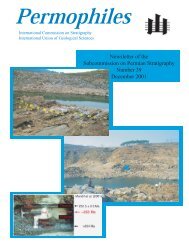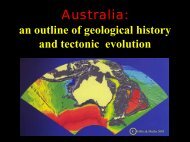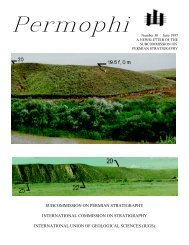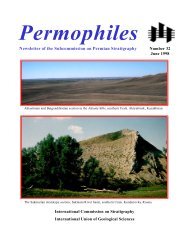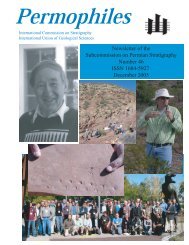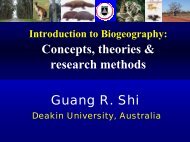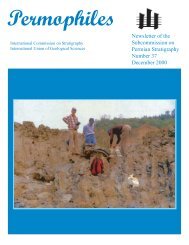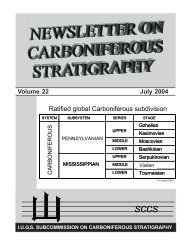Number 31 January 1998 Newsletter of the Subcommission on ...
Number 31 January 1998 Newsletter of the Subcommission on ...
Number 31 January 1998 Newsletter of the Subcommission on ...
You also want an ePaper? Increase the reach of your titles
YUMPU automatically turns print PDFs into web optimized ePapers that Google loves.
Not Heritschioides in Europe Yet<br />
by Edward C. Wils<strong>on</strong><br />
The col<strong>on</strong>ial rugose coral Heritschioides Yabe, 1950 is an<br />
index fossil for uppermost Pennsylvanian and Lower Permian<br />
marine rocks <str<strong>on</strong>g>of</str<strong>on</strong>g> western USA plus western and Arctic Canada<br />
(Wils<strong>on</strong>, 1980 and later reports by several authors). Kossovaja<br />
(1996, 1997) referred to a Late Carb<strong>on</strong>iferous coral from North<br />
Timan (NE European Arctic Russia) as Heritschioides aff. H.<br />
carneyi Wils<strong>on</strong>, 1982, but did not describe or figure it. H. carneyi<br />
originally was described from <str<strong>on</strong>g>the</str<strong>on</strong>g> Upper Pennsylvanian-Lower<br />
Permian McCloud Limest<strong>on</strong>e <str<strong>on</strong>g>of</str<strong>on</strong>g> nor<str<strong>on</strong>g>the</str<strong>on</strong>g>rn California.<br />
This apparent interc<strong>on</strong>tinental geographic range extensi<strong>on</strong><br />
<str<strong>on</strong>g>of</str<strong>on</strong>g> <str<strong>on</strong>g>the</str<strong>on</strong>g> genus may not be justified. I have corresp<strong>on</strong>ded with<br />
Kossovaja (1995) and reviewed photographs <str<strong>on</strong>g>of</str<strong>on</strong>g> her thin secti<strong>on</strong>s<br />
<str<strong>on</strong>g>of</str<strong>on</strong>g> <str<strong>on</strong>g>the</str<strong>on</strong>g> North Timan coral. The corallites are poorly preserved<br />
and somewhat crushed and <str<strong>on</strong>g>the</str<strong>on</strong>g> short cardinal septum,<br />
an obligatory character for <str<strong>on</strong>g>the</str<strong>on</strong>g> Family Heritschioidae Sando,<br />
1985, is not observable. The coral, <str<strong>on</strong>g>the</str<strong>on</strong>g>refore, cannot be firmly<br />
referred to Heritschioides. Fur<str<strong>on</strong>g>the</str<strong>on</strong>g>rmore, Kossovaja’s coral is<br />
so unlike H. carneyi in numbers <str<strong>on</strong>g>of</str<strong>on</strong>g> septa and lengths <str<strong>on</strong>g>of</str<strong>on</strong>g> minor<br />
septa that it cannot be placed in <str<strong>on</strong>g>the</str<strong>on</strong>g> same species group (Wils<strong>on</strong>,<br />
1982, fig. 17) even if it did bel<strong>on</strong>g to <str<strong>on</strong>g>the</str<strong>on</strong>g> genus.<br />
Firm identificati<strong>on</strong> <str<strong>on</strong>g>of</str<strong>on</strong>g> <str<strong>on</strong>g>the</str<strong>on</strong>g> North Timan coral awaits examinati<strong>on</strong><br />
<str<strong>on</strong>g>of</str<strong>on</strong>g> better preserved specimens. Until <str<strong>on</strong>g>the</str<strong>on</strong>g>n, this range extensi<strong>on</strong><br />
<str<strong>on</strong>g>of</str<strong>on</strong>g> such an important index coral genus should be regarded<br />
with cauti<strong>on</strong>.<br />
References<br />
Kossovaja, 0. L., 1996. Correlati<strong>on</strong> <str<strong>on</strong>g>of</str<strong>on</strong>g> uppermost Carb<strong>on</strong>iferous<br />
and Lower Permian rugose coral z<strong>on</strong>es from <str<strong>on</strong>g>the</str<strong>on</strong>g> Urals to<br />
western North America. Palaios 11(l), 71-82.<br />
Kossosvaja, 0. L., 1997. Correlati<strong>on</strong> <str<strong>on</strong>g>of</str<strong>on</strong>g> uppermost Carb<strong>on</strong>iferous<br />
and Lower Permian rugose coral z<strong>on</strong>es from <str<strong>on</strong>g>the</str<strong>on</strong>g> Urals to<br />
western North America (abstract). Fossil Cnidaria & Porifera<br />
25(2), 37.<br />
Sando, W. J., 1985. Paraheritschioides, a new rugose coral<br />
genus from <str<strong>on</strong>g>the</str<strong>on</strong>g> Upper Pennsylvanian <str<strong>on</strong>g>of</str<strong>on</strong>g> Idaho. Journal <str<strong>on</strong>g>of</str<strong>on</strong>g><br />
Pale<strong>on</strong>tology 59, 979-985.<br />
Wils<strong>on</strong>, E. C., 1980. Redescripti<strong>on</strong> <str<strong>on</strong>g>of</str<strong>on</strong>g> type specimens <str<strong>on</strong>g>of</str<strong>on</strong>g> <str<strong>on</strong>g>the</str<strong>on</strong>g><br />
Permian rugose coral Waagenophyllum columbicum<br />
Smith, 1935, type species <str<strong>on</strong>g>of</str<strong>on</strong>g> Heritschioides Yabe, 1950. Journal<br />
<str<strong>on</strong>g>of</str<strong>on</strong>g> Pale<strong>on</strong>tology 54, 85-92.<br />
Wils<strong>on</strong>, E. C., 1982. Wolfcampian rugose and tabulate corals<br />
(Coelenterata: Anthozoa) from <str<strong>on</strong>g>the</str<strong>on</strong>g> Lower Permian McCloud<br />
Limest<strong>on</strong>e <str<strong>on</strong>g>of</str<strong>on</strong>g> nor<str<strong>on</strong>g>the</str<strong>on</strong>g>rn California. C<strong>on</strong>tributi<strong>on</strong>s in Science<br />
337, 1-90.<br />
Yabe, H., 1950. Permian corals resembling Waagenophyllum<br />
and Corwenia. Japan Academy Proceedings 26, 74-79.<br />
E. C. Wils<strong>on</strong><br />
Natural History Museum <str<strong>on</strong>g>of</str<strong>on</strong>g><br />
Los Angeles County<br />
900 Expositi<strong>on</strong> Blvd.<br />
Los Angeles, Ca. 90007 USA<br />
The Permian sequence at Wairaki Downs,<br />
Sou<str<strong>on</strong>g>the</str<strong>on</strong>g>rn New Zealand<br />
by J. B. Waterhouse<br />
The fullest sequence <str<strong>on</strong>g>of</str<strong>on</strong>g> Middle Permian bioz<strong>on</strong>es in New<br />
Zealand is found at Wairaki Downs, an area <str<strong>on</strong>g>of</str<strong>on</strong>g> low rolling hills<br />
east <str<strong>on</strong>g>of</str<strong>on</strong>g> <str<strong>on</strong>g>the</str<strong>on</strong>g> Takitimu Mountains, where older Permian rocks are<br />
exposed. The mid-1950’s and 1960’s saw initial mapping and<br />
descripti<strong>on</strong> <str<strong>on</strong>g>of</str<strong>on</strong>g> about 200 species <str<strong>on</strong>g>of</str<strong>on</strong>g> mostly brachiopods and<br />
molluscs, and recogniti<strong>on</strong> <str<strong>on</strong>g>of</str<strong>on</strong>g> a number <str<strong>on</strong>g>of</str<strong>on</strong>g> bioz<strong>on</strong>es (Mutch 1972,<br />
Waterhouse 1964, 1982). Subsequently <str<strong>on</strong>g>the</str<strong>on</strong>g> area has been<br />
mapped in more detail, using a base-map at 1:6800. It has been<br />
found that although <str<strong>on</strong>g>the</str<strong>on</strong>g> successi<strong>on</strong> <str<strong>on</strong>g>of</str<strong>on</strong>g> z<strong>on</strong>es has been correctly<br />
ordered, several are separated by low-angle thrusts, which<br />
have brought toge<str<strong>on</strong>g>the</str<strong>on</strong>g>r rocks from different sources. Many <str<strong>on</strong>g>of</str<strong>on</strong>g><br />
<str<strong>on</strong>g>the</str<strong>on</strong>g> thrusts involve Jurassic sediment. The new mapping and<br />
careful examinati<strong>on</strong> <str<strong>on</strong>g>of</str<strong>on</strong>g> <str<strong>on</strong>g>the</str<strong>on</strong>g> faunas show that claims <str<strong>on</strong>g>of</str<strong>on</strong>g> “broken<br />
formati<strong>on</strong>s” by Landis (1 987) and purported revisi<strong>on</strong>s and correlati<strong>on</strong>s<br />
in Campbell et al. (1996) may be set aside. The successi<strong>on</strong><br />
may be briefly summarized.<br />
Wairaki Downs Group<br />
The Wairaki Downs Group overlies <str<strong>on</strong>g>the</str<strong>on</strong>g> Early Permian<br />
(Cisuralian) Takitimu Group, as part <str<strong>on</strong>g>of</str<strong>on</strong>g> a basaltic andesitic volcanic<br />
arc and associated sediment called <str<strong>on</strong>g>the</str<strong>on</strong>g> Brook Street Terrane.<br />
The group c<strong>on</strong>tains faunas <str<strong>on</strong>g>of</str<strong>on</strong>g> seven successive brachiopod<br />
z<strong>on</strong>es in three formati<strong>on</strong>s: Caravan, <str<strong>on</strong>g>of</str<strong>on</strong>g> very coarse clastics,<br />
Letham which grades northwards from <str<strong>on</strong>g>the</str<strong>on</strong>g> upper Caravan into<br />
deeper water siltst<strong>on</strong>es and carb<strong>on</strong>ates, and Mangarewa which<br />
grades southwards from coarse sediment into thicker carb<strong>on</strong>ates<br />
and fine clastics. Landis (1987) claimed <str<strong>on</strong>g>the</str<strong>on</strong>g> Letham and<br />
Mangarewa were inseparable, and c<strong>on</strong>stituted a broken formati<strong>on</strong>,<br />
but allowed he had not mapped <str<strong>on</strong>g>the</str<strong>on</strong>g>m. Fossils are numerous<br />
and occur in bioz<strong>on</strong>es which may be correlated with <str<strong>on</strong>g>the</str<strong>on</strong>g><br />
bioz<strong>on</strong>es recognized in <str<strong>on</strong>g>the</str<strong>on</strong>g> sou<str<strong>on</strong>g>the</str<strong>on</strong>g>ast Bowen Basin <str<strong>on</strong>g>of</str<strong>on</strong>g> central<br />
Queensland (Waterhouse 1987). Structural data and fossils<br />
suggest that <strong>on</strong>e bioz<strong>on</strong>e has been substantially thinned by a<br />
low angle thrust just above <str<strong>on</strong>g>the</str<strong>on</strong>g> base <str<strong>on</strong>g>of</str<strong>on</strong>g> <str<strong>on</strong>g>the</str<strong>on</strong>g> Mangarewa Formati<strong>on</strong>.<br />
New overviews <str<strong>on</strong>g>of</str<strong>on</strong>g> east Australian ages by Roberts et al.<br />
(1996) and Jin and Menning (1996) suggest that <str<strong>on</strong>g>the</str<strong>on</strong>g> bioz<strong>on</strong>es<br />
range through Kungurian and Guadalupian, based partly <strong>on</strong><br />
Australian amm<strong>on</strong>oid data, radiometric values and paleomagnetic<br />
lllawarra Reversal. Of course <str<strong>on</strong>g>the</str<strong>on</strong>g> correlati<strong>on</strong>s with world<br />
stratotypes must be putative and indirect, because no c<strong>on</strong>od<strong>on</strong>ts<br />
are present.<br />
Glendale Formati<strong>on</strong><br />
The Wairaki Downs Group is overlain unc<strong>on</strong>formably by Jurassic<br />
c<strong>on</strong>glomerate <str<strong>on</strong>g>of</str<strong>on</strong>g> <str<strong>on</strong>g>the</str<strong>on</strong>g> Elsdun Formati<strong>on</strong>, and separated<br />
from clastics and massive limest<strong>on</strong>e <str<strong>on</strong>g>of</str<strong>on</strong>g> <str<strong>on</strong>g>the</str<strong>on</strong>g> Glendale Formati<strong>on</strong><br />
by a low angle thrust. The thrust is partly intruded by <str<strong>on</strong>g>the</str<strong>on</strong>g><br />
igneous Weetwood Formati<strong>on</strong>. Newly found fossils bel<strong>on</strong>g to<br />
<str<strong>on</strong>g>the</str<strong>on</strong>g> Plek<strong>on</strong>ella multicostata Z<strong>on</strong>e, <strong>on</strong>e <str<strong>on</strong>g>of</str<strong>on</strong>g> several z<strong>on</strong>es correlated<br />
with Late Permian <str<strong>on</strong>g>of</str<strong>on</strong>g> <str<strong>on</strong>g>the</str<strong>on</strong>g> Himalaya and Salt Range<br />
(Waterhouse 1978). This bioz<strong>on</strong>e is better developed elsewhere<br />
in <str<strong>on</strong>g>the</str<strong>on</strong>g> New Zealand Permian, and may be poorly represented in<br />
<str<strong>on</strong>g>the</str<strong>on</strong>g> upper South Curra Limest<strong>on</strong>e <str<strong>on</strong>g>of</str<strong>on</strong>g> <str<strong>on</strong>g>the</str<strong>on</strong>g> Gympie Basin <str<strong>on</strong>g>of</str<strong>on</strong>g> sou<str<strong>on</strong>g>the</str<strong>on</strong>g>ast<br />
Queensland. It seems likely that <str<strong>on</strong>g>the</str<strong>on</strong>g> Glendale developed<br />
as part <str<strong>on</strong>g>of</str<strong>on</strong>g> a separate Maitai Terrane, which c<strong>on</strong>verged <strong>on</strong> Brook<br />
15



